An Inductor-Loaded Single-Port Planar Dual-Broadband Antenna with Stable Gains
Abstract
1. Introduction
2. Materials and Methods
3. Results
4. Discussion
5. Conclusions
Author Contributions
Funding
Data Availability Statement
Conflicts of Interest
References
- Luk, K.M.; Wong, H. A new wideband unidirectional antenna element. J. Microw. Opt. Technol. 2006, 1, 35–44. [Google Scholar]
- An, W.; Lau, K.; Li, S.; Xue, Q. Wideband E-shaped dipole antenna with staircase-shaped feeding strip. J. Electron. Lett. 2010, 46, 1583–1584. [Google Scholar] [CrossRef]
- Jia, F.; Zheng, Z.; Wang, Q.; Liu, P.; Liao, S.; Che, W.; Xue, Q. A Novel Cross-Band Decoupled Shared-Antenna Configuration with Scattering Suppression for Radiation Pattern Distortion Mitigation of Base Station. J. IEEE Trans. Antennas Propag. 2022, 70, 6006–6011. [Google Scholar] [CrossRef]
- Li, J.; Li, J.; Yin, C.; Guo, H.Z.; Zhao, Z. A Miniaturized Dual-Band Dual-Polarized Base Station Antenna Loaded with Duplex Baluns. J. IEEE Antennas Wirel. Propag. Lett. 2023, 3, 1–5. [Google Scholar] [CrossRef]
- Liu, X.; Gao, S.; Sanz-Izquierdo, B.; Zhang, H.; Wen, L.; Hu, W.; Luo, Q.; Sumantyo, J.T.S.; Yang, X.-X. A Mutual-Coupling-Suppressed Dual-Band Dual-Polarized Base Station Antenna Using Multiple Folded-Dipole Antenna. J. IEEE Trans. Antennas Propag. 2022, 70, 11582–11594. [Google Scholar] [CrossRef]
- Huang, H.; Liu, Y.; Gong, S. A dual-broadband, dual-polarized base station antenna with high isolation for 2G/3G/4G applications. J. IEEE Antennas Wirel. Propag. Lett. 2017, 16, 1111–1114. [Google Scholar] [CrossRef]
- Wu, R.; Chu, Q.-X. A Compact, Dual-Polarized Multiband Array for 2G/3G/4G Base Stations. J. IEEE Trans. Antennas Propag. 2019, 67, 2298–2304. [Google Scholar] [CrossRef]
- Chu, Q.-X.; Wu, Y.-S.; Chang, Y.-L. A Novel Electromagnetic Transparent Antenna in Dual-Band Shared-Aperture Array. J. IEEE Trans. Antennas Propag. 2022, 70, 9894–9899. [Google Scholar] [CrossRef]
- He, D.; Yu, Q.; Chen, Y.; Yang, S. Dual-Band Shared-Aperture Base Station Antenna Array with Electromagnetic Transparent Antenna Elements. J. IEEE Trans. Antennas Propag. 2021, 69, 5596–5606. [Google Scholar] [CrossRef]
- Lau, K.; Kong, K.; Luk, K. Dual-band stacked folded shorted patch antenna. J. Electron. Lett. 2007, 43, 789–790. [Google Scholar] [CrossRef]
- An, W.; Shen, Z.; Wang, J. Compact Low-Profile Dual-Band Tag Antenna for Indoor Positioning Systems. J. IEEE Trans. Antennas Wirel. Propag. Lett. 2016, 16, 400–403. [Google Scholar] [CrossRef]
- Cui, Y.; Li, R.; Wang, P. Novel Dual-Broadband Planar Antenna and Its Array for 2G/3G/LTE Base Stations. J. IEEE Trans. Antennas Propag. 2013, 61, 1132–1139. [Google Scholar] [CrossRef]
- He, Y.; Huang, W.; He, Z.; Zhang, L.; Gao, X.; Zeng, Z. A Novel Cross-Band Decoupled Shared-Aperture Base Station Antenna Array Unit for 5G Mobile Communications. J. Open J. Antennas Propag. 2022, 3, 583–593. [Google Scholar] [CrossRef]
- Qin, Y.; Li, R.; Xue, Q.; Zhang, X.; Cui, Y. Aperture-Shared Dual-Band Antennas with Partially Reflecting Surfaces for Base-Station Applications. J. IEEE Trans. Antennas Propag. 2021, 70, 3195–3207. [Google Scholar] [CrossRef]
- Sim, C.Y.D.; Chen, C.C.; Zhang, X.Y.; Lee, Y.L.; Chiang, C.Y. Very Small-Size Uniplanar Printed Monopole Antenna for Dual-Band WLAN Laptop Computer Applications. J. IEEE Trans Antennas Propagat. 2017, 65, 2916–2922. [Google Scholar] [CrossRef]
- Sun, X.L.; Liu, L.; Cheung, S.W.; Yuk, T.I. Dual-band Antenna with Compact Radiator for 2.4/5.2/5.8 GHz WLAN Applications. J. IEEE Trans Antennas Propagat. 2012, 60, 5924–5931. [Google Scholar] [CrossRef]
- Sim, C.Y.D.; Chien, H.Y.; Lee, C.H. Dual-/Triple-Band Asymmetric Dipole Antenna for WLAN Operation in Laptop Computer. J. IEEE Trans Antennas Propagat. 2013, 61, 3808–3813. [Google Scholar] [CrossRef]
- Lee, C.T.; Su, S.W.; Chen, S.C.; Fu, C.S. Low-cost, Direct-Fed Slot Antenna Built in Metal Cover of Notebook Computer for 2.4-/5.2-/5.8-GHz WLAN Operation. J. IEEE Trans Antennas Propagat. 2017, 65, 2677–2682. [Google Scholar] [CrossRef]
- Sim, D.U.; Choi, J.-I. A compact wideband modified planar inverted F antenna (PIFA) for 2.4/5 GHz WLAN applications. In Proceedings of the 2005 IEEE 62nd Vehicular Technology Conference, Dallas, TX, USA, 27 September 2005; pp. 1304–1307. [Google Scholar]
- Luo, Z.-K.; Su, T.; Xu, K.-D. A Single-Layer Low-Profile Dual-Wideband Monopolar Patch Antenna with Shorting Vias and Parasitic Annular Sectors. J. IEEE Antennas Wirel. Propag. Lett. 2023, 22, 432–436. [Google Scholar] [CrossRef]
- An, W.; Wang, H.; Luo, Y. Dual-Band Antenna Integrated With Solar Cells for WLAN Applications. J. Front. Phys. 2021, 9, 775214. [Google Scholar] [CrossRef]
- Yang, S.J.; Duan, W.; Liu, Y.Y.; Ye, H.; Yang, H.; Zhang, X.Y. Compact dual-band base-station antenna using filtering elements. J. IEEE Trans. Antennas Propag. 2022, 70, 7106–7111. [Google Scholar] [CrossRef]
- Li, Y.; Zhao, Z.; Tang, Z.; Yin, Y. Differentially Fed, Dual-Band Dual-Polarized Filtering Antenna With High Selectivity for 5G Sub-6 GHz Base Station Applications. J. IEEE Trans. Antennas Propag. 2019, 68, 3231–3236. [Google Scholar] [CrossRef]
- Liu, W.C.; Chen, J.K. Dual-band twin stepped-patch monopole antenna for WLAN application. J. Electron. Lett. 2009, 45, 929–931. [Google Scholar] [CrossRef]
- Ye, L.H.; Li, Y.J.; Wu, D.L. Dual-Wideband Dual-Polarized Dipole Antenna with T-Shaped Slots and Stable Radiation Pattern. J. IEEE Antennas Wirel. Propag. Lett. 2022, 21, 610–614. [Google Scholar] [CrossRef]
- Li, Z.; Han, J.; Mu, Y.; Gao, X.; Li, L. Dual-Band Dual-Polarized Base Station Antenna with a Notch Band for 2/3/4/5G Communication Systems. J. IEEE Antennas Wirel. Propag. Lett. 2020, 19, 2462–2466. [Google Scholar] [CrossRef]
- Feng, B.; An, W.; Yin, S.; Deng, L.; Li, S. Dual-Wideband Complementary Antenna with a Dual-Layer Cross-ME-Dipole Structure for 2G/3G/LTE/WLAN Applications. J. IEEE Antennas Wirel. Propag. Lett. 2014, 14, 626–629. [Google Scholar] [CrossRef]
- Tao, J.; Feng, Q.; Liu, T. Dual-Wideband Magnetoelectric Dipole Antenna With Director Loaded. J. IEEE Antennas Wirel. Propag. Lett. 2018, 17, 1885–1889. [Google Scholar] [CrossRef]
- Liu, T.; Zhu, W.J.; Hu, X.J.; Ye, L.H.; Wu, D.-L. Dual-Wideband Dual-Polarized Magnetoelectric Dipole Antenna for Sub-6 GHz Applications. J. IEEE Antennas Wirel. Propag. Lett. 2023, 2, 3243572. [Google Scholar] [CrossRef]
- An, W.X.; Wong, H.; Lau, K.L.; Li, S.F.; Xue, Q. Design of Broadband Dual-Band Dipole for Base Station Antenna. J. IEEE Trans. Antennas Propag. 2012, 60, 1592–1595. [Google Scholar] [CrossRef]
- Zhang, H.; Jiao, Y.-C.; Weng, Z. A Novel Dual-Wideband Directional Dipole Antenna with Double Reflecting Floors. J. IEEE Antennas Wirel. Propag. Lett. 2017, 16, 1941–1944. [Google Scholar] [CrossRef]
- Alieldin, A.; Huang, Y.; Boyes, S.J.; Stanley, M.; Joseph, S.D.; Hua, Q.; Lei, D. A Triple-Band Dual-Polarized Indoor Base Station Antenna for 2G, 3G, 4G and Sub-6 GHz 5G Applications. J. IEEE Access 2018, 6, 49209–49216. [Google Scholar] [CrossRef]
- Kim, J.; Jo, G.; Park, W. Two-inductor loaded loop antenna for mobile phones. J. Electron. Lett. 2011, 47, 736–737. [Google Scholar] [CrossRef]
- Othman, M.A.; Abuelfadl, T.M.; Safwat, A.M.E. Dual and Wide-Band Inductively-Loaded Dipole-Based Antennas for WLAN/UMTS Applications. J. IEEE Trans. Antennas Propag. 2012, 61, 1430–1435. [Google Scholar] [CrossRef]
- Available online: https://www.mouser.cn/datasheet/2/445/744917082-1103175.pdf (accessed on 10 November 2015).
- Available online: https://www.mouser.cn/datasheet/2/445/744917068-1103359.pdf (accessed on 10 November 2015).
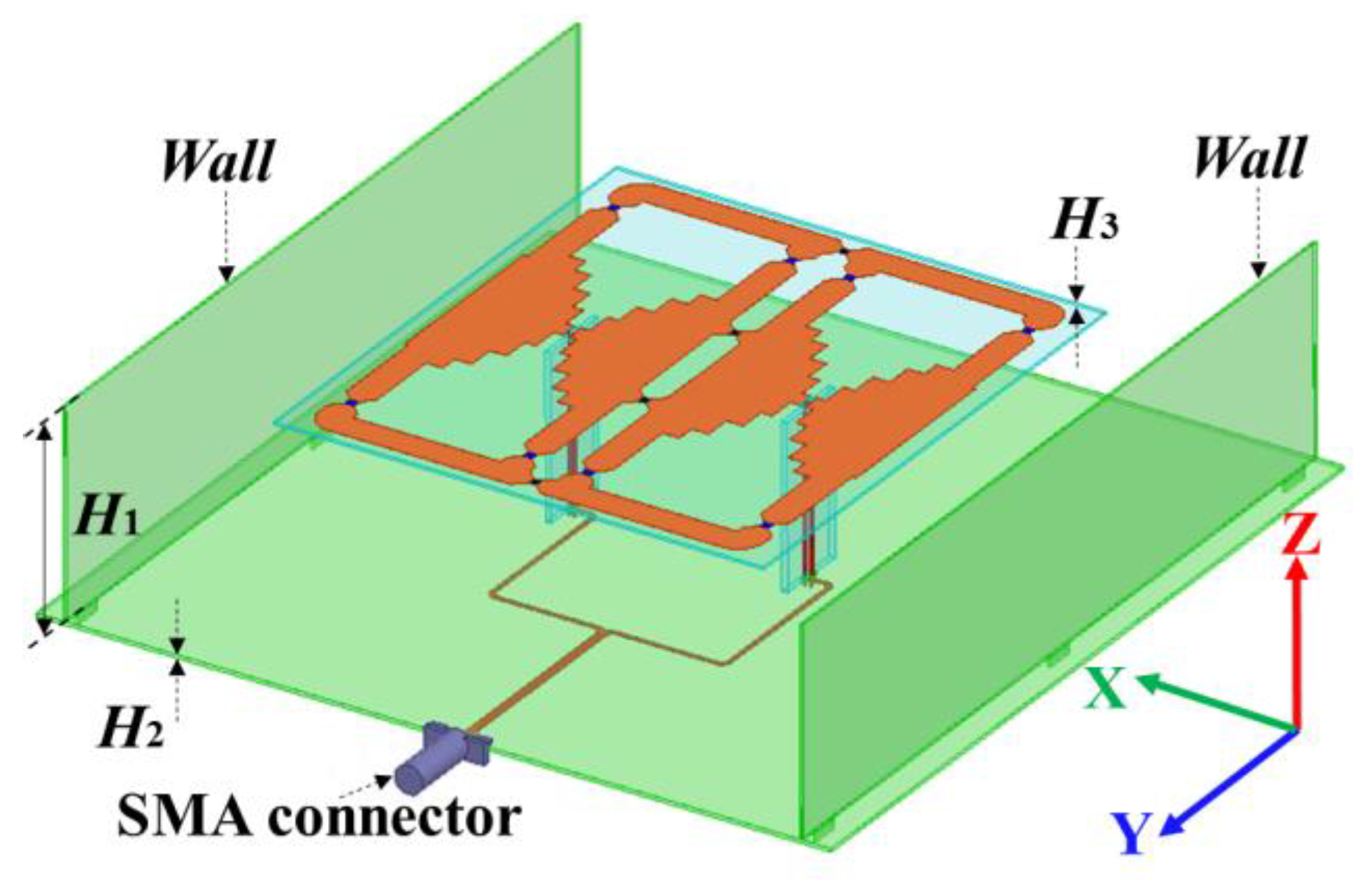
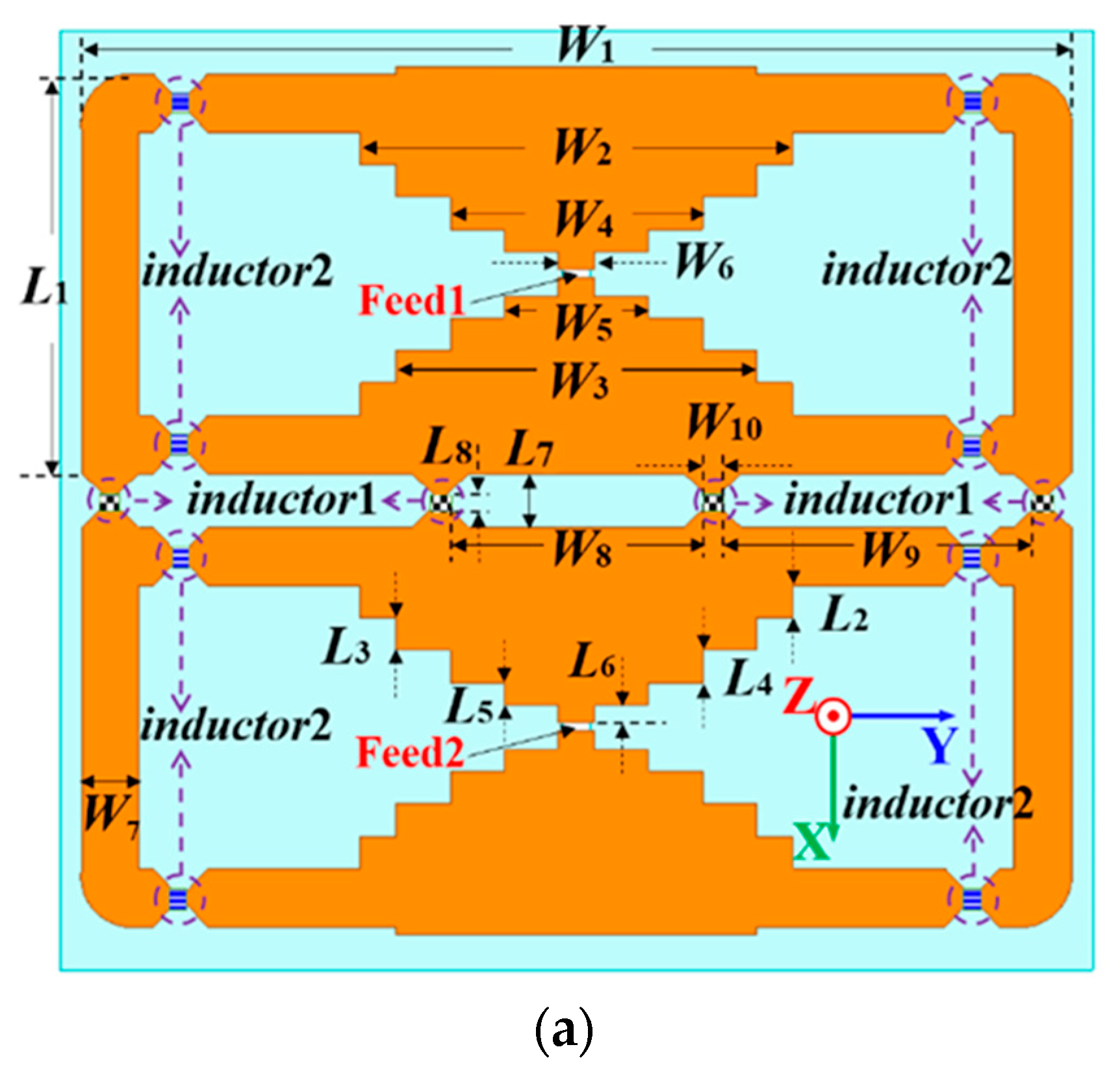
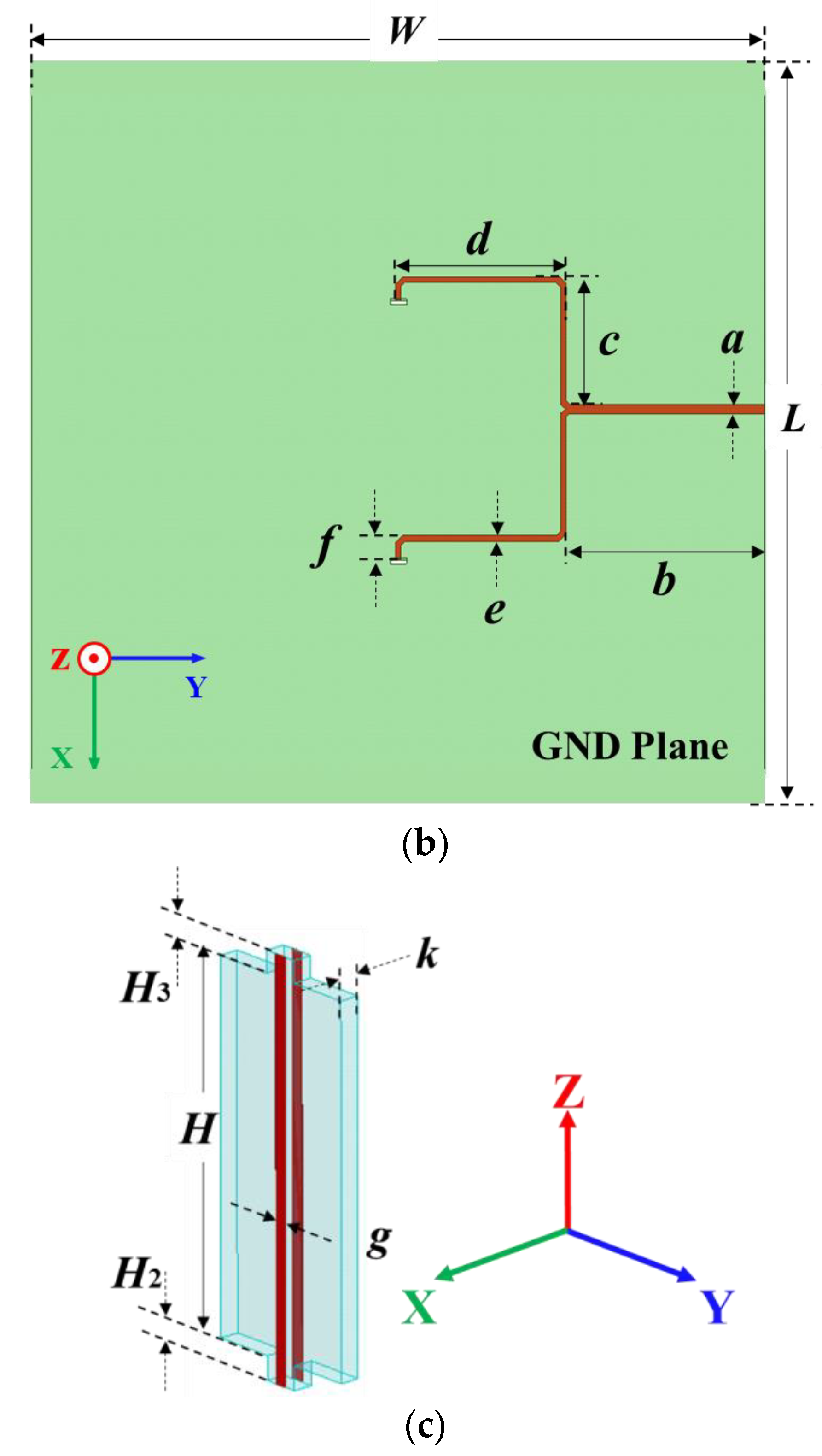
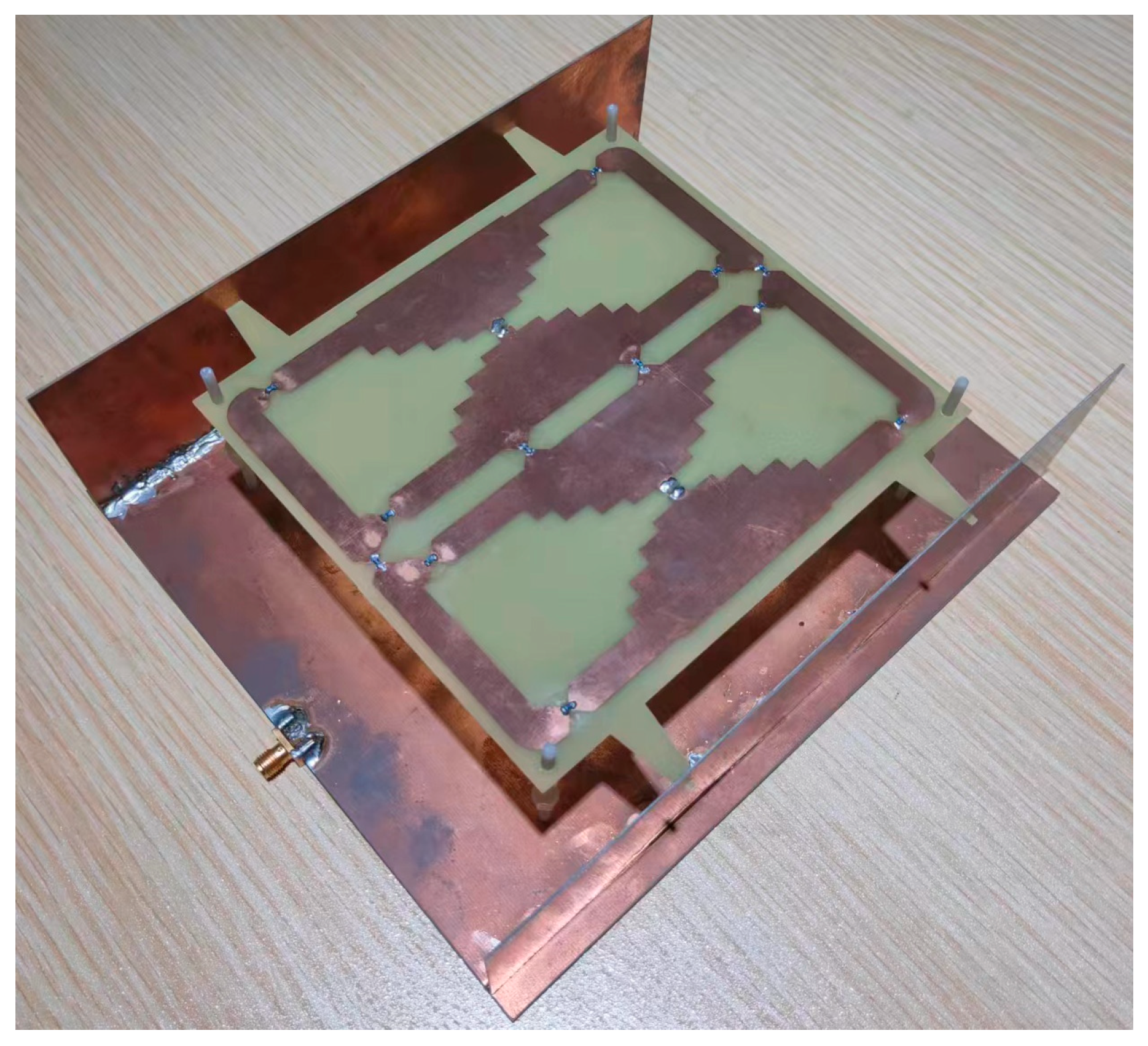

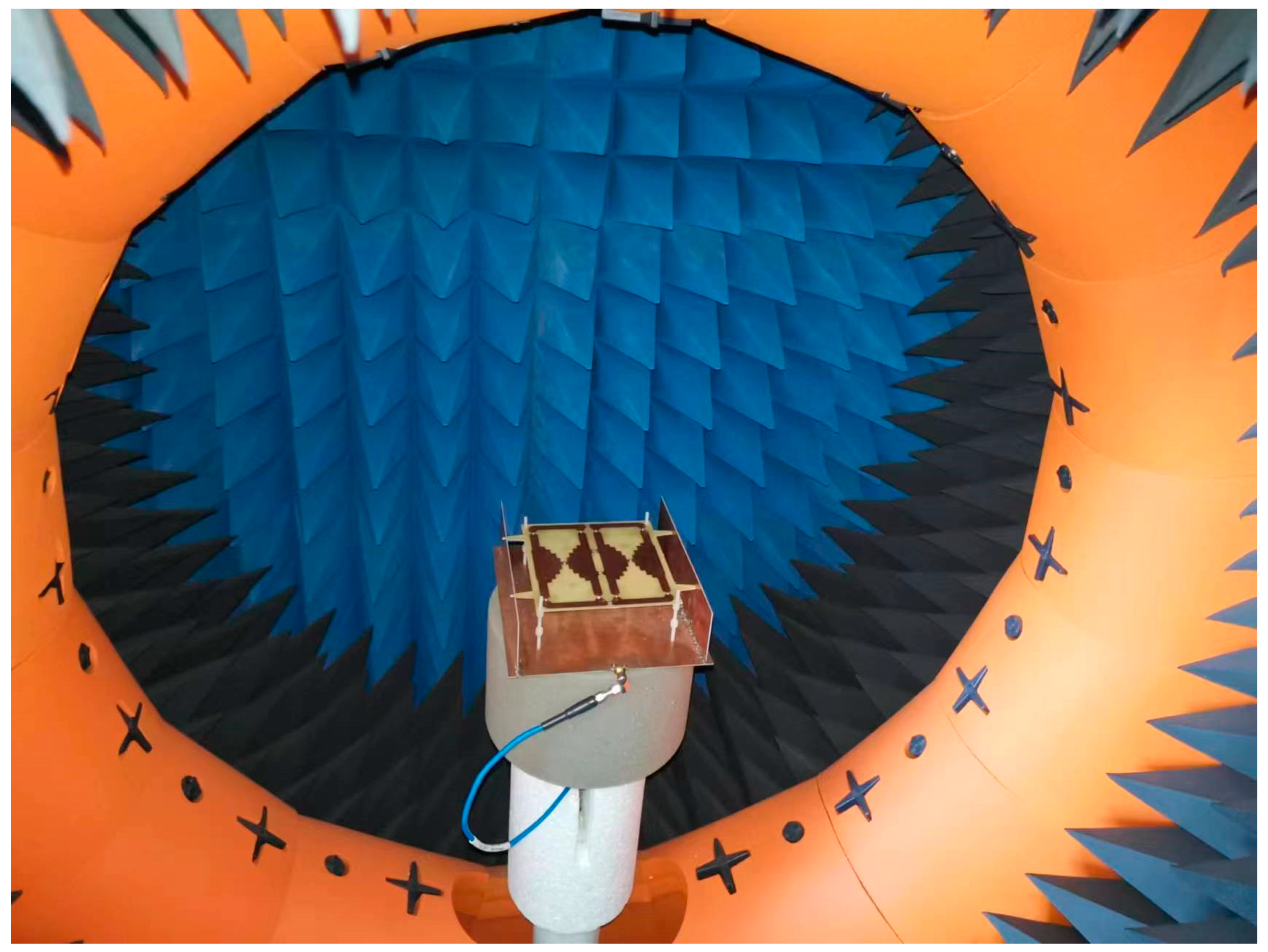


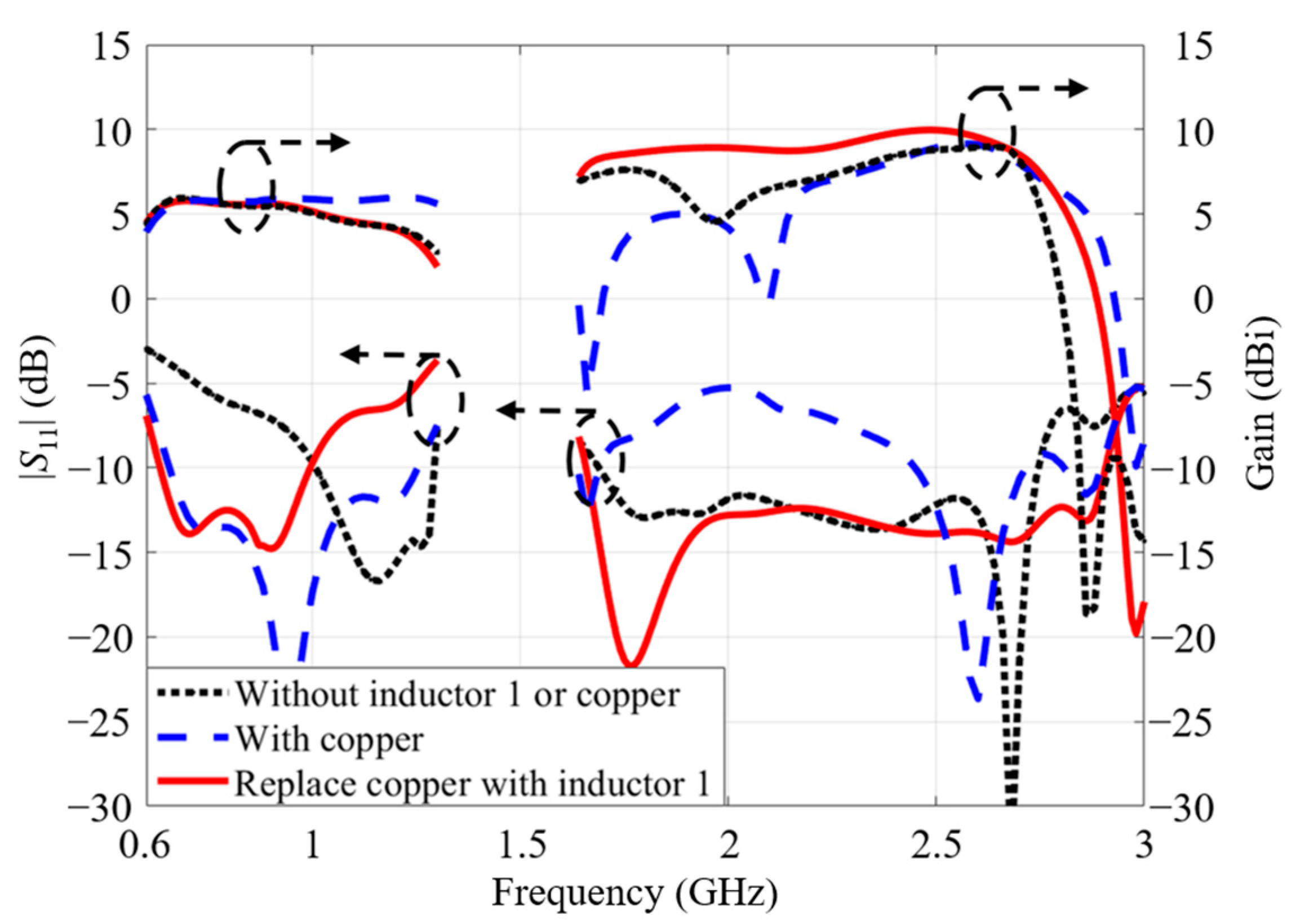

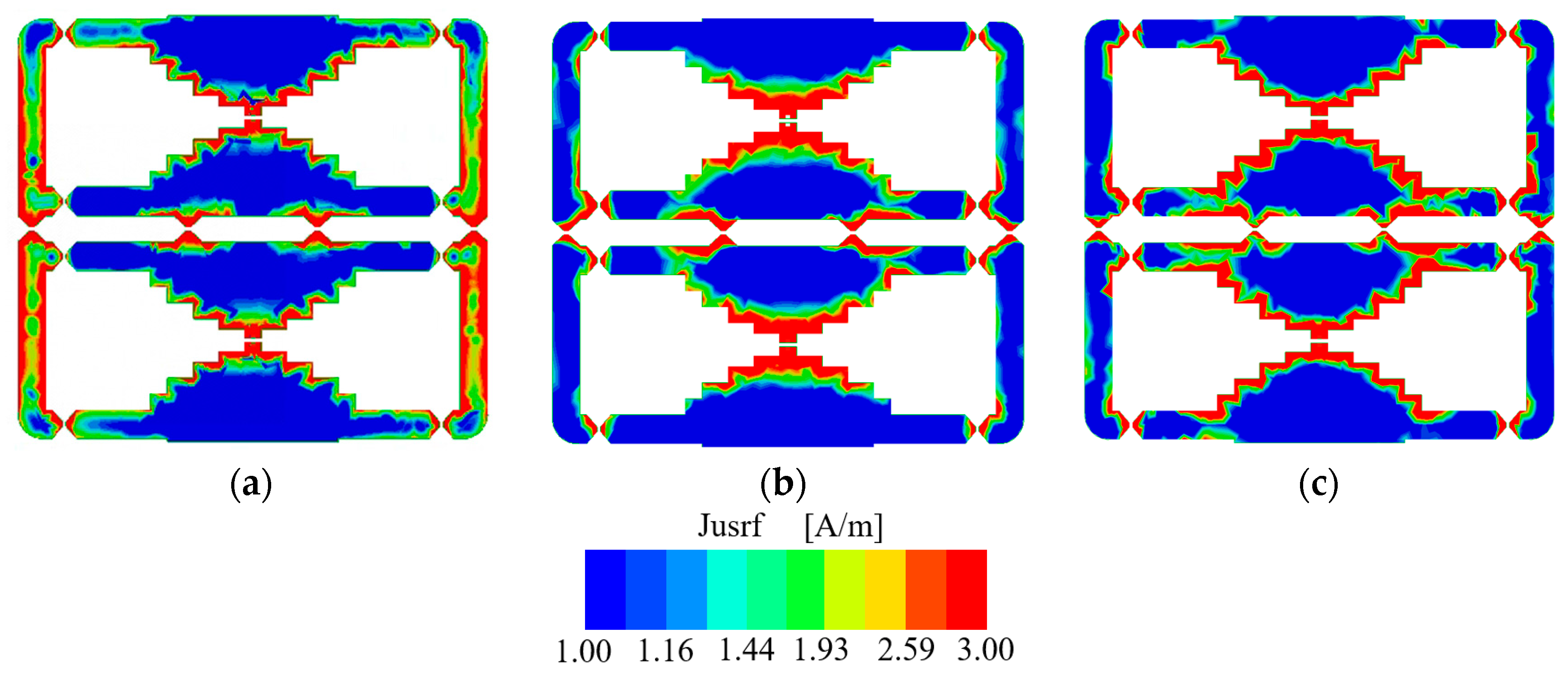

| Ref. | Low Band High Band (GHz) | Relative Bandwidth (%) | Gain Variation (LB, HB) (dB) | Radiation Structure Layers | Single Port for Dual-Band |
|---|---|---|---|---|---|
| [8] | 1.65~2.7, 3.3~3.8 | 48.3%, 14% | 2, 1.4 | 2 | No |
| [9] | 1.8~2.7, 3.3~3.8 | 40.0%, 14% | 2, 3 | 2 | No |
| [10] | 0.764~0.962, 1.548~1.898 | 22.9%, 20.3% | N.A. | 2 | No |
| [11] | 0.88~0.91, 2.9~5.35 | 3.6%, 59.5% | 0.4, 2.1 | 1 | No |
| [12] | 0.78~0.98, 1.47~3 | 22%, 68% | 1, 0.8 | 1 | No |
| [13] | 0.69~0.96, 1.7~2.7 | 32.7%, 45.5% | 1.2, 1.4 | 2 | No |
| [14] | 0.69~0.98, 1.7~2.73 | 36%, 46.5% | 0.3, 1.7 | 4 | No |
| [15] | 2.35~2.51, 4.90~6 | 6.4%, 19.5% | 0.6, 0.4 | 1 | Yes |
| [16] | 2.39~2.5, 5~6.06 | 4.5%, 19.2% | 0.1, 2.5 | 1 | Yes |
| [17] | 2.37~2.56, 5.06~5.39 | 7.7%, 6.3% | 0.3, 0.5 | 1 | Yes |
| [18] | 2.4~2.5, 4.75~6 | 4.1%, 23.3% | 0.2, 1 | 1 | Yes |
| [19] | 2.36~2.5, 2.94~5.8 | 5.8%, 69% | 0.2, 2.5 | 1 | Yes |
| [20] | 2.37~2.63, 5.52~6.37 | 10.4%, 14.3% | 3, 2.5 | 1 | Yes |
| [21] | 2.27~2.5, 4.8~6.9 | 9.6%, 35.9% | 4, 3.5 | 1 | Yes |
| [22] | 2.5~2.7, 3.3~3.8 | 7.7%; 14% | 1.5, 1 | 3 | Yes |
| [23] | 3.28~3.71, 4.8~5.18 | 12.3%, 7.6% | 0.78, 2.16 | 2 | Yes |
| [24] | 2.32~3.03, 4.77~6.33 | 26.5%, 28.1% | N.A. | 2 | Yes |
| [25] | 1.67~2.72, 3.3~3.9 | 47.8%, 16.6% | 1.2, 0.9 | 2 | Yes |
| [26] | 1.55~2.75, 3.3~3.8 | 55.8%, 14% | 0.7, 0.4 | 3 | Yes |
| [27] | 1.68~2.84, 5.3~5.95 | 51.3%, 11.4% | 3.5, 2.5 | 2 | Yes |
| [28] | 2.3~3.7, 5~6.25 | 46.7%, 22.2% | 0.7, 3.2 | 3 | Yes |
| [29] | 1.74~2.6, 3.34~5.08 | 39.6%, 41.3% | 1.1, 6.2 | 3 | Yes |
| [30] | 0.78~1.1, 1.58~2.62 | 34%, 49.5% | 1.5, 4 | 2 | Yes |
| [31] | 0.68~1.03, 1.67~2.8 | 40.5%, 50.6% | 1, 3.5 | 2 | Yes |
| [32] | 0.7~0.96, 1.7~3, 3.3~3.8 | 31.3%, 55.3%, 14% | 2, 3, 0.9 | 2 | Yes |
| This work | 0.64~1, 1.59~2.82 | 43.9%, 55.8% | 1, 2.2 | 1 | Yes |
| Para. | L | L1 | L2 | L3 | L4 | L5 | L6 | L7 |
| Value | 181 | 55.25 | 4.5 | 4.5 | 4.5 | 3 | 2.54 | 7.5 |
| Para. | L8 | W | W1 | W2 | W3 | W4 | W5 | W6 |
| Value | 1 | 205 | 137.5 | 60 | 50 | 35 | 20 | 5 |
| Para. | W7 | W8 | W9 | W10 | H | H1 | H2 | H3 |
| Value | 8 | 36.54 | 44.54 | 1.3 | 43.4 | 55 | 0.9 | 0.7 |
| Para. | a | b | c | d | e | f | g | k |
| Value | 2 | 57.13 | 30.75 | 45.75 | 0.75 | 5.72 | 0.75 | 1.1 |
| Parameter | Performance |
|---|---|
| Frequency range | 30 KHz~4 GHz |
| Port | 2 |
| Dynamic range | >100 dB |
| Amplitude accuracy | ±0.5 dB |
| Temperature range | −10~+55 °C |
| Parameter | Performance |
|---|---|
| Frequency range | 650 MHz~6 GHz |
| Typical dynamic range | 70 dB |
| Peak gain accuracy | >±1.5 dB |
| −10 dB sidelobe accuracy | >±1.6 dB |
| −20 dB sidelobe accuracy | >±4.6 dB |
Disclaimer/Publisher’s Note: The statements, opinions and data contained in all publications are solely those of the individual author(s) and contributor(s) and not of MDPI and/or the editor(s). MDPI and/or the editor(s) disclaim responsibility for any injury to people or property resulting from any ideas, methods, instructions or products referred to in the content. |
© 2023 by the authors. Licensee MDPI, Basel, Switzerland. This article is an open access article distributed under the terms and conditions of the Creative Commons Attribution (CC BY) license (https://creativecommons.org/licenses/by/4.0/).
Share and Cite
An, W.; Xu, X.; Wang, J.; Li, S. An Inductor-Loaded Single-Port Planar Dual-Broadband Antenna with Stable Gains. Micromachines 2023, 14, 1233. https://doi.org/10.3390/mi14061233
An W, Xu X, Wang J, Li S. An Inductor-Loaded Single-Port Planar Dual-Broadband Antenna with Stable Gains. Micromachines. 2023; 14(6):1233. https://doi.org/10.3390/mi14061233
Chicago/Turabian StyleAn, Wenxing, Xinyu Xu, Jian Wang, and Shenrong Li. 2023. "An Inductor-Loaded Single-Port Planar Dual-Broadband Antenna with Stable Gains" Micromachines 14, no. 6: 1233. https://doi.org/10.3390/mi14061233
APA StyleAn, W., Xu, X., Wang, J., & Li, S. (2023). An Inductor-Loaded Single-Port Planar Dual-Broadband Antenna with Stable Gains. Micromachines, 14(6), 1233. https://doi.org/10.3390/mi14061233








